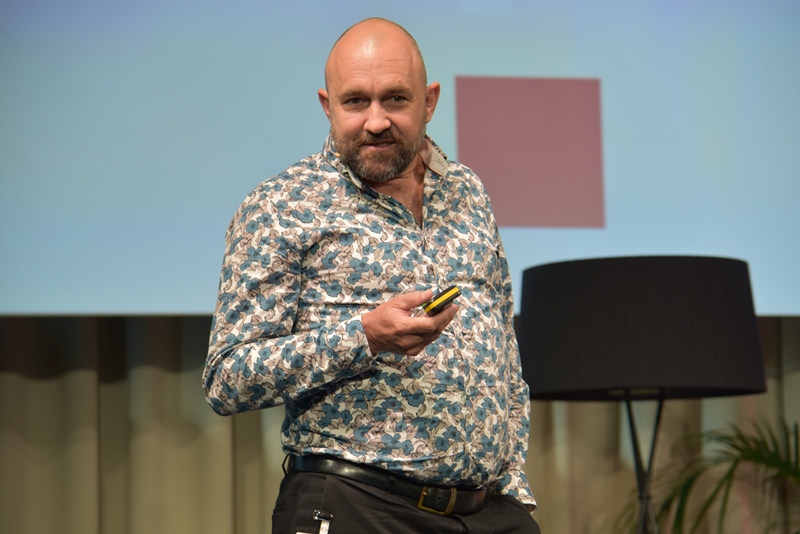And yet they look!
Television is alive - but needs to become more flexible, also in terms of advertising. These are the key findings of Screenforce Day 2019.
Screenforce Day 2019 is over - and when it next takes place in 2020, the Swiss TV industry is likely to have moved on quite a bit. At least, that's what you have to assume if you believe the presentations at the event. Because in order to take into account the increasing individualization in viewer behavior, action must be taken quickly.
The challenges facing the medium of TV served as a kind of red thread for the event. The "digital natives" of "Generation Z" have long since stopped consuming moving images in a linear fashion, but in parallel on multiple channels. So are they lost to classic TV - and TV advertising?
And, following on from that, can a gold standard for measuring multichannel consumption be established that allows advertising to be placed even more precisely than it is today?

Alain Messerli presented the Screenforce Switzerland study.
With these questions, it stands to reason that the results of the latest Screenforce Switzerland study were eagerly awaited. The study surveyed 1,000 people between the ages of 16 and 29 in German-speaking Switzerland. With today's diverse range of moving images, the researchers asked themselves in their study "Television - The Quality Time of Digital Natives" what role TV plays in the media consumption of young people.
Contrary to the widespread assumption that TV is hardly relevant for young people anymore, the study comes to the conclusion that digital natives do watch TV. The young testimonials, who were repeatedly played in videos, describe TV consumption as valuable time, as "quality time" that they would often spend in company. In stark contrast to social media consumption, which they describe as stressful, time spent in front of the TV is relaxation for them. If this is true for the majority of young people, their receptivity to advertising would thus be significant.
The results of the study "The Contribution of TV to Advertising Success," which Günter Linke, Director Research at Dentus Aegis Resolutions, presented afterwards, go in a similar direction. The study, which he conducted for Screenforce, explored the question of whether TV is still effective in times of fragmented media consumption. The results can be interpreted to mean that TV is still the biggest driver of awareness and sales compared to other media. Even with small and medium budgets, according to Günter Linke, playing out advertising on TV is worthwhile.

Tanja Hackenbruch in conversation with moderator Wolfram Kons.
Tanja Hackenbruch and Mirko Marr presented the project "Online TV Audience Measurement" after a networking break. The big question that arises: Can the standard of TV measurement be transferred to the digital world and will it then become a convergent and comparable moving image currency? Mediapulse's project aims to equip the TV panel accordingly and automatically measure its use of online.
When people talk about TV today, they are always talking about time-shifted use. The topic of "replay" was hotly debated in parliament at the end of last year, and the issue is still topical. Beatrice Kniel, Chief Marketing Officer & Managing Director Broadcast at Admeira, and Alexander Duphorn, CEO Goldbach Media, explained why time-shifted use is both a curse and a blessing for advertising. The changed circumstances demand new forms of advertising, they agreed. Because without advertising, TV stations lack the most important basis for financing. Alexander Duphorn and Beatrice Kniel showed what such new forms of advertising might look like.
Afterwards, Alexander Duphorn took the time to conduct an in-depth interview with werbewoche.ch on the topic. You can listen to it in full here:
Prof. Wolfgang Henseler from Sensory-Minds GmbH took a look into the near and somewhat more distant future. In his presentation, he showed how innovative technologies and user-centricity are changing the TV market. According to Wolfgang Henseler, the digital transformation is a mental transformation. A change in thinking is required: "Those who think in a user-centric way are successful. If we think in terms of brands and not in terms of user experience, we will no longer exist in ten years. It's all about the benefits of technology for people." In the future, it will be about Smart Ecosystems: User-centric, anything, anytime, anywhere, situationally relevant. Thinking in terms of classic TV channels has to change to user experience.
Henseler closed the event with this inspiring outlook - until the industry meets again on September 26 for the "Screen-up".

In principle, the Swiss Advertisers Association is positive about these measures. As SWA Director Roland Ehrler said on the fringes of Screenforce Day: "SWA supports the decisions of the Mediapulse Board of Directors, all the more so because the association has a seat and a voice there. That's why the SWA welcomes Mediapulse's intentions to measure TV consumption on other devices as well."
At the same time, Ehrler added: "However, advertisers want not only reach measurement of traditional TV consumption on all devices, but also independent moving image measurement for all relevant platforms. This is the only way to get an overall picture and perhaps soon a uniform moving image currency?"








